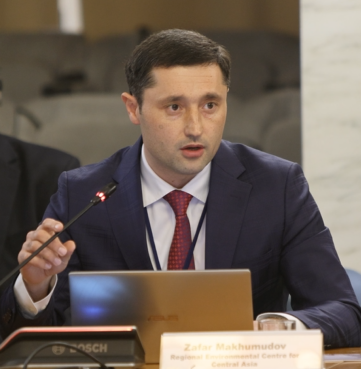During the last week of February, Rome hosted a significant event – the Seventh High-Level Conference of the EU - Central Asia – devoted to climate change, the environment and water resources.
Representatives of the governments of the EU and Central Asian countries discussed pressing issues of modern climate realities and the possibility of expanding political dialogue in the field of environmental protection, climate change and water resources in Central Asia.

The theme of green investment and a green transition, especially for countries most vulnerable to climate change, has been omnipresent at all global level events. The Executive Director of the Regional Environmental Center for Central Asia (CAREC), Zafar Makhmudov, emphasized Central Asia’s high vulnerability to climate impacts in his speech at the session “Environmental Protection, Water Resources and Climate Change in Central Asia” of the High-Level Conference in Rome.
- You underlined the importance of Central Asia on the green global agenda in your speech at the Seventh High-Level Conference in Rome. In your opinion, how Central Asia fits in the current global context for the green transition and climate-resilient economic development?
- Let me start by saying that one of the CAREC’s goals in Central Asia is to create an environment where governments of Central Asian countries take significant climate actions. CAREC develops and supports a regional community of experts with the highest standards of professional practice on climate change, adaptation, mitigation, and water and energy issues. We actively support building a climate dialogue at the intergovernmental, national, and regional levels with the involvement of civil society and international organizations.
Currently, we cannot say that the region is ready for the transition to a green economy. I think this is true for every other country in the world as well. To date, we can say with confidence how ready we are to move towards climate-resilient development and what we have achieved in this way.
Today, all Central Asian countries have developed national policies, strategies and action programmes focusing on climate-resilient development. Moreover, Central Asian governments continue key policy reforms and support regional initiatives and green growth strategies at the national and regional levels. In that light, the issue of green investment becomes highly relevant to the region, and CAREC is working actively in this direction.
We strive to draw the attention of the international climate community to the investment needs of the region. At the recent Seventh High-Level Conference EU-Central Asia, CAREC contributed to the thematic session on attracting investment in infrastructure projects that ensure water, energy and food security and green growth. We discussed how to engage the private sector in financing infrastructure projects. CAREC introduced four draft proposals for investments in the Central Asian countries. They were developed within the project “Central Asia Nexus Dialogue” funded by the European Union and implemented by CAREC. We face, of course, some challenges during negotiations on attracting internal and external financing for investment proposals.
Participation in the events like the Seventh Conference in Rome allow us to discuss and share experiences in the successful promotion of investment proposals, and to know which projects and conditions attract interest from small and medium businesses. Moreover, we may present to the donors the full potential of the region. For example, the donors expressed willingness to continue supporting the Central Asian governments in providing technical assistance and external funding at our thematic session. However, they stressed that the involvement of the private sector is a prerequisite for sustainable development.
This session gathered over 40 representatives from the private sector, experts, NGOs and government agencies. Based on its results, we prepared recommendations on attracting the private sector to finance infrastructure projects. CAREC presented these recommendations to the top leadership of the sectoral ministries of the EU and CA countries at the Seventh High-Level Conference for consideration during the political dialogue in the field of environmental protection in the region.
- What does CAREC consider an important requirement for an effective green transition?
- The very name of the CAREC’s side event at the Seventh High-Level Conference EU – Central Asia can be the answer to your question – transparency as the foundation for an effective transition green transition and achievement of sustainable development goals.
CAREC’s project on the Establishment of the Regional Climate Action Transparency Hub for Central Asia (ReCATH) is addressing the issue of transparency as a basis for green growth. The ReCATH is a project of the Initiative for Climate Action Transparency (ICAT), which supports countries in developing their capacity to build and manage a robust, transparent framework that enables them to effectively implement the Paris Agreement and facilitates countries' transition to new reporting under the Enhanced Transparency Framework (ERF). To this end, ICAT has created a toolkit with transparency modelling methodologies and tools that can be adapted to countries’ needs.
Currently, the ReCATH has adopted and implemented a collaborative approach that brings together the five Central Asian states and supports technical experts and expert institutions in the region to build sustainable and integrated measurement, reporting and verification transparency systems.
Thus, Central Asian countries should integrate climate change into all national planning tools; strengthen institutional coordination and technical capacity for climate change policy development; and implement activities in relevant sectors.
Climate-oriented integration will ultimately contribute to the green economy development in the region.
By Zhanna Husainova
Photo by courtesy of Aizhan Kossantayeva
.jpg)
.jpg)
_анонс_и_тело_нов.jpg)
